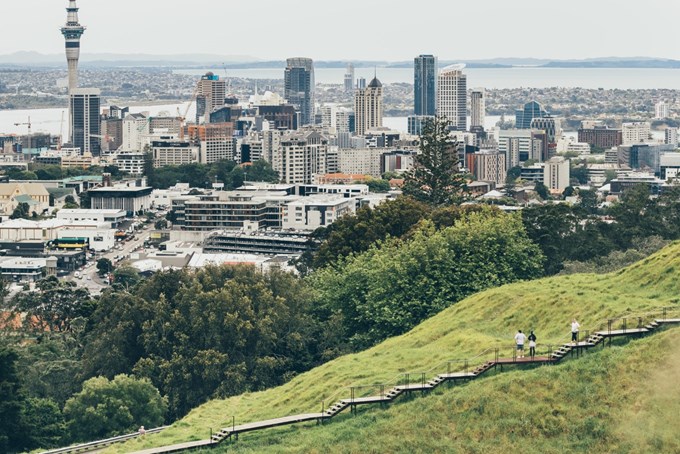They say change starts from within, and that’s the approach Auckland Council is applying to cutting its corporate carbon emissions. From electrifying the vehicle fleet to phasing out gas heating from facilities, we’re eyeing every corner of the organisation to become the cleanest, greenest council we can be.
“Reaching our wider goal of halving Auckland’s CO2 emissions by 2030 is going to depend on the individual actions of organisations, so we’ve got to be part of that,” says Kirk Archibald, Auckland Council’s Lead Corporate Sustainability Advisor.
“We’ve already committed publicly to action through the climate emergency declaration and Te Tāruke-ā-Tāwhiri: Auckland’s Climate Plan. Now it’s time to lead by example.”
Here are just some of the ways Auckland Council is playing its part in delivering a low-emissions, climate-resilient future for Tāmaki Makaurau:
Saying goodbye to gas
Aquatic centres are responsible for a whopping 32% of the council's total greenhouse gas emissions, 75% of which is produced by the gas boilers used for heating. That’s why aquatic centres are the first target in the council’s programme to phase out fossil fuels from all its facilities.
The first major project has just been completed at Moana-Nui-a-Kiwa Pool and Leisure Centre in Māngere, where a new electric heat pump will reduce the centre’s GHG emissions by over 60% — the equivalent of taking 130 cars off the road for a year. Similar projects are underway at Westwave and Onehunga War Memorial Pool & Leisure Centre.
As well as switching from gas to electricity, a major solar installation at Albany Stadium Pool is nearing completion, while Massey Aquatic Centre in Papakura has had solar water heating since 2019.
Building a lean, green vehicle fleet
Auckland Council’s vehicle fleet accounts for around 14% of its total greenhouse gas emissions. We’ve set a target of halving fleet emissions by 2025, with plans for at least 358 EVs by 2025.
“We’re focussed on optimising the use of vehicles and improving the systems we’ve got so that we don’t need as many cars on the road,” says Ross Sanford, Auckland Council’s workplace travel manager.
Measures to reduce reliance on the fleet include encouraging staff to book out e-bikes or hop cards for work-related travel, enabling flexible working and video conferencing, and ensuring offices are located near transport hubs.
“These actions have helped the council to remove 101 combustion vehicles from the fleet in the past 18 months,” says Mr Sanford.
“The challenge is now utes and SUVs that we need for specific purposes, but electric alternatives are coming online in the next few years. It’s absolutely feasible that by 2030 the fleet will be fully electrified, as well as being much smaller,” Mr Sanford says.
Pruning the portfolio
Where five years ago the council owned 12 offices across the region, these are being consolidated into four main hubs in Central Auckland, Manukau, Henderson and Albany.
“This action will reduce the size of our office accommodation from around 105,000m2 to 55,000m2 by 2026, which will in turn cut GHG emissions in half,” says Peter Young, Auckland Council’s principal property advisor, corporate property services.
Further emissions reductions are expected through efficiency improvements to existing buildings, while any new office builds, or other facilities are required to be carbon neutral and meet a minimum Green Star rating of five.
“If we’re adding a new building, it shouldn’t add any new sources of greenhouse gas emissions. It’s really important that we’re not going backwards,” says Mr Archibald.
The council’s new Albany hub, due to be completed later this year, will have a Green Star rating of 6 for its interior fit-out. This is the highest available rating and represents world leadership in environmentally sustainable building practices.
Planting the parks
Auckland’s regional parks aren’t just pretty spots for weekend walks—they have an important role to play in reducing the council’s carbon footprint.
Under the Ngahere Planting Programme, Auckland Council has committed to planting 200ha of permanent native ngahere (forest) in our regional parks over the next ten years. This is in addition to 83ha already planned by regional parks.
Over the 2022 planting season, 128,000 plants, or 12.8 hectares will be planted in collaboration with the mayor’s Million Trees programme at Anawhata, Te Arai and Mahurangi East regional parks. Plantings will be on unproductive farmland that is unsuitable for grazing.
By 2031, this planting and a small reduction in livestock will reduce the council’s GHG emissions by over 1,300 tonnes of CO2 per year, or around 5% of its total emissions.
To 2050, and beyond
Thanks to these larger efforts and many other smaller changes, Auckland Council’s carbon emissions are continuing to decline each year.
“Emissions were down 11% in FY20/21 from their peak in FY17/18, and we expect the FY21/22 numbers to show further reductions once they are confirmed soon,” says Mr Archibald.
While this is great news, the hard work doesn’t stop there. Auckland Council will continue striving to reach our emissions goal of net zero by 2050, both as an organisation and for Tāmaki Makaurau.
To learn more about Auckland Council’s commitment to climate action, visit Auckland Forever. And if you’d like to know how you can make a difference, check out your personal impact on the planet at Future Fit.


